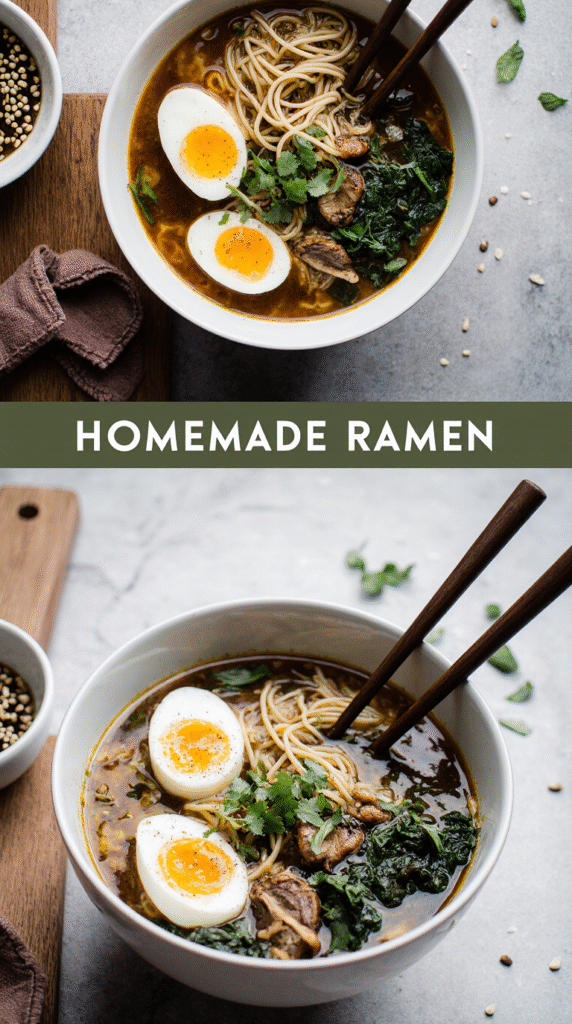The Secret to Restaurant-Quality Ramen Recipe (Chef-Approved Guide)
Ramen recipe enthusiasts know there’s a world of difference between a quick 20-minute noodle bowl and the soul-warming experience of authentic Japanese ramen. While I appreciate the convenience of those “I-have-a-package-of-ramen-and-some-vegetables-can-we-make-lunch” moments, there’s nothing quite as comforting as a properly crafted bowl of homemade ramen with savory noodles and a rich, flavorful broth.
Although making authentic Japanese ramen from scratch requires time, patience, and effort, the results are absolutely worth it. In this comprehensive guide, I’ll walk you through creating a homemade ramen recipe that rivals your favorite restaurant’s version. Whether you’re interested in classic shoyu ramen, shio ramen, miso ramen, or tonkotsu ramen, you’ll discover how to customize the broth and toppings exactly to your preference. From building the perfect umami-rich broth to selecting the ideal noodles and creating those showstopping toppings like nitamago (marinated eggs) and chashu (pork belly), we’ll cover everything you need to know to elevate your ramen game.
The Four Pillars of Restaurant-Quality Ramen
Creating restaurant-quality ramen requires mastering four fundamental components that work together to deliver that authentic Japanese experience. Each element contributes uniquely to the bowl’s overall harmony and flavor profile. Let me break down these essential pillars that separate mediocre homemade ramen from truly exceptional bowls.
1. The broth: building deep umami flavor
The soul of any great ramen recipe lies in its broth. Traditional ramen broths typically combine at least two to three stocks, creating layers of flavor impossible to achieve with a single base. Most authentic recipes follow a formula of pork/chicken broth plus dashi. Dashi, made from kombu (kelp) and katsuobushi (dried bonito), provides that distinctive umami punch that separates Japanese ramen from other Asian noodle soups.
Four primary ramen broth types exist: shoyu (soy sauce), shio (salt), miso (fermented bean paste), and tonkotsu (pork bone). Notably, tonkotsu requires boiling pork bones for 4-48 hours until the broth becomes milky white and opaque. For enhanced flavor, many chefs char aromatics like onions and garlic before adding them to the broth.
2. The noodles: choosing the right texture
Despite the broth often stealing the spotlight, noodles remain equally crucial to crafting perfect ramen. Made from wheat flour, salt, water, and kansui (alkaline mineral water), authentic ramen noodles develop their distinctive springy texture and slight yellowish hue from this alkaline component.
Different broths pair best with specific noodle types. Thin, straight noodles complement lighter broths like shio or shoyu, allowing subtle flavors to shine. Thick, wavy noodles excel with rich, creamy tonkotsu, as their curves capture the dense broth. Medium curly noodles work beautifully with miso ramen, offering balanced texture and broth absorption.
3. The toppings: balancing taste and texture
Toppings transform good ramen into exceptional ramen by adding contrasting textures and complementary flavors. Traditional options include green onions, bean sprouts, wood ear mushrooms, bamboo shoots (menma), seaweed, and naruto (fish cake).
Menma, the fermented bamboo shoots, provides a smooth surface with crunchy texture that complements the firmness of ramen noodles. Meanwhile, nori (seaweed) adds visual appeal with its striking dark color plus a briny, oceanic flavor note. Even a simple pat of butter can enhance miso-based ramens by deepening the umami flavor.
4. The protein: from chashu to tofu
The protein component often defines the ramen experience. Chashu, thinly sliced braised pork belly, reigns as the most iconic ramen protein. Traditionally simmered in soy sauce, mirin, sake, and aromatics until fall-apart tender, proper chashu should be buttery soft with balanced meat and fat.
For vegetarians and vegans, tofu chashu offers a plant-based alternative with similar savory, sweet, and smoky flavors. Prepared by marinating firm tofu in soy sauce, maple syrup, and liquid smoke before baking and broiling, it develops a meaty texture and rich flavor profile. Additionally, tempeh provides another plant-based option with 19 grams of protein per 100 grams.
How to Make Ramen at Home Like a Chef
Crafting restaurant-quality ramen at home is all about technique and timing. With the right approach, you can create a bowl that rivals your favorite ramen shop. Let’s break down the process into manageable steps that will transform your homemade ramen recipe.
Step 1: Prepare your ramen broth base
First, choose your broth style – whether tonkotsu, shoyu, or miso. For a tonkotsu broth, blanch pork bones in boiling water for 5 minutes, then rinse thoroughly to remove impurities. This crucial step ensures a clear, flavorful broth rather than a cloudy, dark one. Afterward, simmer bones at a rolling boil for 12 hours, maintaining water levels to keep bones submerged. For added depth, char onions, garlic, and ginger before adding to the broth. In case you’re short on time, combine chicken broth with kombu and bonito flakes for a simplified dashi that still delivers authentic flavor.
Step 2: Cook and season your noodles
Never cook your noodles directly in the broth! Instead, boil them separately in plenty of unsalted water according to package directions – usually 3-4 minutes. Once cooked, strain thoroughly for 5-10 seconds to prevent excess water from diluting your broth. Subsequently, fold the noodles in your serving bowl to separate the strands, making them easier to pick up with chopsticks. Fresh noodles are ideal, but dried Japanese ramen with sodium carbonate or potassium carbonate in the ingredients list works well too.
Step 3: Soft-boil and marinate your eggs
For perfect ramen eggs (ajitsuke tamago), bring water to a boil and gently lower room-temperature eggs into the pot. Simmer precisely 6-7 minutes depending on desired jamminess. Immediately transfer to an ice bath for at least 15 minutes. Peel carefully, then marinate in a mixture of soy sauce, mirin, sake, and sugar for 4-24 hours. Importantly, cover the eggs with a paper towel during marination to ensure even flavor absorption.
Step 4: Sear or braise your protein
Traditional chashu pork requires braising belly in soy sauce, sake, mirin, and aromatics until melt-in-your-mouth tender. For a faster option, sear chicken breast in olive oil until golden, then slice after resting. Vegetarians can opt for firm tofu marinated in soy-based sauce. Whatever protein you choose, slice it thinly just before assembly to maintain optimal texture and temperature.
Step 5: Assemble and garnish
Assembly order matters tremendously! Place your tare (seasoning base) in the bowl first, followed by hot broth to mix evenly. Add noodles, then arrange toppings strategically – protein at 6 o’clock, egg at 12 o’clock, and nori at the side. Finally, garnish with sliced green onions, sesame seeds, or chili oil. Serve immediately, as noodles continue cooking in the hot broth and will become soggy if left too long.
Pro Tips for Authentic Ramen Flavor
The secret to truly authentic ramen flavor lies in mastering a few chef techniques that elevate your homemade bowl from good to exceptional. Beyond the fundamentals, these pro tips will help you capture those elusive restaurant-quality flavors in your kitchen.
Use dashi or kombu for umami depth
The foundation of Japanese ramen recipe begins with dashi, a simple yet profound broth component. Chefs use kombu (dried kelp) and katsuobushi (bonito flakes) to create layers of umami that ordinary broths lack. For maximum flavor extraction, soak kombu in cold water overnight rather than boiling it, which preserves its delicate oceanic notes. Furthermore, adding shiitake mushroom powder alongside kombu creates a thyroid-healing stock with distinctive umami characteristics. Even instant dashi (hondashi) combined with miso and soy sauce transforms basic broths into something that feels like authentic restaurant ramen.
Add tare for layered seasoning
Tare is essentially the “secret sauce” of ramen—the concentrated flavoring added to the bowl before the broth. Most ramen shops jealously guard their tare recipes because this component is what truly differentiates one establishment from another. Typically, tare follows the golden ratio of Japanese cooking: 8 parts dashi to 1 part soy sauce and 1 part mirin. The three primary types are shoyu (soy-based), shio (salt-based), and miso (fermented soybean paste). Chefs place approximately 2 tablespoons of tare at the bottom of each bowl before adding hot broth, consequently allowing flavors to blend perfectly.
Cook noodles separately to avoid cloudy broth
Cooking noodles directly in your ramen broth is a common mistake that compromises quality. When boiled separately, noodles release excess starch into the cooking water rather than clouding your meticulously prepared broth. Moreover, separate cooking gives you better control over the noodles’ doneness and texture. Drain thoroughly before adding to your bowl—ramen broth doesn’t benefit from pasta water the way Italian sauces do.
Use mirin and soy sauce for balance
The interplay between sweet mirin and savory soy sauce creates the balanced flavor profile characteristic of authentic Japanese ramen. Professional chefs often combine these ingredients in specific ratios—particularly following the 1:1 ratio of soy sauce to mirin when building tare. In essence, this combination provides both the salt and sweetness needed to round out complex flavors. For quick improvement, even a splash of soy sauce enhances the salty, savory characteristics of basic ramen.
Finish with sesame oil or chili oil
A final drizzle of oil is the chef’s secret weapon for complete flavor transformation. Toasted sesame oil adds nutty depth that makes ramen taste complete—often it’s that “something missing” element you can’t quite identify in restaurant versions. For heat lovers, chili oil or chili crisp adds both spice and satisfying texture. As a result, these finishing oils create a rich, mouthwatering quality that makes it difficult to stop eating.
Customizing Your Homemade Ramen Recipe
The beauty of homemade ramen lies in its flexibility. Once you’ve mastered the basics, your ramen recipe becomes a blank canvas for endless personalization based on dietary preferences, flavor profiles, and available ingredients.
Vegetarian and vegan ramen options
Plant-based ramen can be just as satisfying as traditional versions. For a robust vegan broth, combine roasted vegetables, kombu, and both fresh and dried mushrooms to create deep umami flavor. Unlike meat-based versions, vegan broths rely on ingredients like miso, dried shiitake, roasted garlic, or toasted sesame for complexity. For protein, crispy tofu works wonderfully—coat firm tofu cubes with cornstarch, olive oil, and tamari before pan-frying or baking. Beyond tofu, edamame provides an impressive 18 grams of protein per cup.
Spicy miso vs. shoyu vs. tonkotsu
Each ramen style offers unique characteristics worth exploring. Miso ramen, born in Hokkaido in the mid-1960s, features fermented soybean paste that adds sweet-tangy thickness to either clear or tonkotsu broth. Shoyu ramen uses Japanese soy sauce as its primary seasoning, creating a clearer, lighter profile. In contrast, tonkotsu requires boiling pork bones for several hours until collagen and fat break down, producing that distinctive milky appearance. For a spicy kick, add gochujang, doubanjiang, or homemade chili oil.
Toppings to try: nori, corn, bamboo shoots
Toppings transform good ramen into exceptional ramen. Nori (dried seaweed) contributes oceanic aroma and crispy texture. Sweet corn adds vibrant color and bursts of sweetness—especially popular in miso ramen from Hokkaido. Menma (fermented bamboo shoots) offers a nutty, briny flavor with satisfying crunch. Other worthy additions include wakame seaweed, karashi takana (spicy pickled mustard greens), bean sprouts, and kikurage (wood ear mushrooms).
Using leftovers creatively
Transform leftover ramen broth into congee by simmering with rice until it breaks down. Alternatively, use it as a flavorful base for stir-fry sauce or gravy. For proteins and vegetables, ramen welcomes practically any leftovers—rotisserie chicken, roasted vegetables, or unused produce that might otherwise go to waste.
Making it kid-friendly
For children, simplify flavors while maintaining appeal. Try adding familiar vegetables like carrots, mild protein options, and less spice. Even a tablespoon of mild green curry paste adds subtle flavor without overwhelming young palates. Some kid-approved additions include butter, corn, and minimal seasonings.
Conclusion
Making restaurant-quality ramen at home certainly requires time and attention to detail, but after reading this guide, you now have all the knowledge needed to create a truly exceptional bowl. The four pillars—broth, noodles, toppings, and protein—work together harmoniously to deliver that authentic Japanese experience.
Remember, the soul of great ramen lies in its broth. Whether you choose tonkotsu, shoyu, miso, or shio, taking the time to develop those deep, complex flavors will undoubtedly elevate your homemade creation. Additionally, selecting the right noodle type for your chosen broth style makes a significant difference in the overall eating experience.
Your choice of toppings and protein further personalizes each bowl. From classic chashu pork to vegetarian alternatives like marinated tofu, these components transform good ramen into something truly spectacular. Even small touches like perfectly jammy eggs or a final drizzle of sesame oil can take your ramen from homemade to restaurant-worthy.
Most importantly, don’t feel confined to traditional recipes. Once you master the basics, ramen becomes your canvas for creativity. Leftover vegetables, different protein options, or unique spice combinations allow you to craft a signature bowl that reflects your personal taste preferences.
Though authentic ramen requires patience, the reward comes with that first spoonful of rich, flavorful broth and perfectly cooked noodles. This labor of love delivers comfort food at its finest—a bowl that nourishes both body and soul. So gather your ingredients, set aside some time, and prepare to amaze yourself and others with your newfound ramen expertise. After all, few homemade dishes deliver such impressive results or inspire such culinary pride as a properly crafted bowl of ramen.
FAQs
Q1. What are the key components of a restaurant-quality ramen? A restaurant-quality ramen consists of four main elements: a flavorful broth, perfectly cooked noodles, complementary toppings, and a well-prepared protein. The broth provides the base flavor, while the noodles offer texture. Toppings add variety in taste and texture, and the protein, such as chashu pork or marinated tofu, completes the dish.
Q2. How can I make my ramen broth more flavorful at home? To enhance your ramen broth’s flavor, use a combination of stocks, such as pork/chicken broth with dashi. Add umami-rich ingredients like kombu (kelp) and katsuobushi (dried bonito). Char aromatics like onions and garlic before adding them to the broth. Finally, use tare (a concentrated seasoning) to add depth and complexity to your broth.
Q3. What’s the best way to cook ramen noodles? Cook ramen noodles separately in unsalted boiling water for 3-4 minutes, or according to package instructions. Drain thoroughly for 5-10 seconds to prevent excess water from diluting the broth. Never cook the noodles directly in the ramen broth, as this can make it cloudy and affect the overall flavor.
Q4. How can I make restaurant-style ramen eggs at home? To make perfect ramen eggs (ajitsuke tamago), soft-boil room-temperature eggs for 6-7 minutes, then immediately transfer them to an ice bath. Peel carefully and marinate in a mixture of soy sauce, mirin, sake, and sugar for 4-24 hours. Cover the eggs with a paper towel during marination to ensure even flavor absorption.
Q5. Can I make a vegetarian or vegan version of ramen? Absolutely! For a vegetarian or vegan ramen, create a robust broth using roasted vegetables, kombu, and both fresh and dried mushrooms. Use miso, dried shiitake, roasted garlic, or toasted sesame for complexity. For protein, try crispy tofu, tempeh, or edamame. You can customize the toppings with various vegetables and plant-based options to create a satisfying meat-free ramen bowl.


